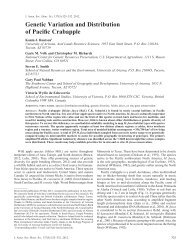CONSERVATION
Conservation You Can Taste - The Southwest Center - University of ...
Conservation You Can Taste - The Southwest Center - University of ...
- No tags were found...
Create successful ePaper yourself
Turn your PDF publications into a flip-book with our unique Google optimized e-Paper software.
miraculous. Amish deer tongue lettuce seed is now offered by 23 seed catalogs and its<br />
fresh greens are found on at least 441 commercial farms. Radiator Charlie’s mortgage lifter<br />
tomato was only offered by Southern Exposure Seeds in the early eighties but is now sold<br />
by 17 different seed catalogs, and is grown on 301 commercial farms in the U.S.<br />
When we try to discern the driving factors of this re-diversification, it is clear that for<br />
the heirloom vegetables, legumes, tuber and grains we selected, the links to local identity,<br />
culture and community were important for most (12) varieties, while taste options to<br />
industrialized food (10) and promoting diversity in backyard production in urban or<br />
suburban settings were key.<br />
While the pace of the genetic engineering of transgenic crops, their patenting and<br />
licensing and potential contamination of open-pollinated vegetable and grain crops<br />
continue to worry food justice activists, potential solutions to some of these problems are<br />
now emerging. For example, the Open Source Seed Initiative has engaged the Organic<br />
Seed Alliance, small seed companies, universities and non-profits in seeking means to<br />
keep vegetable, grain, legume, and tuber varieties in the public domain rather than being<br />
further privatized. In the meantime, planting a diversity of crop species—most of them<br />
still free of any risk of GMO contamination—is the best bet for keeping variety in our<br />
produce in North America.<br />
To get such diversity out to more people—including low-income families—more<br />
than one hundred public access “seed libraries” have cropped up in the U.S. over the last<br />
five years. In addition, food justice activist Daniel Bowman Simon has alerted tens of<br />
thousands of low-income families that their SNAP benefits through USDA Food and<br />
Nutrition programs can be used to purchase heirloom vegetable seeds, seedlings and<br />
fruit tree cuttings to produce diverse food for multiple meals, rather than using the same<br />
support for purchasing just a few meals from a grocery store. Many farmers markets<br />
vendors are now regularly accepting SNAP program payments to put fresh foods and<br />
propagation materials (seeds, cuttings and tubers) in the hands of the poor, but much<br />
more needs to be done along these lines.<br />
18



